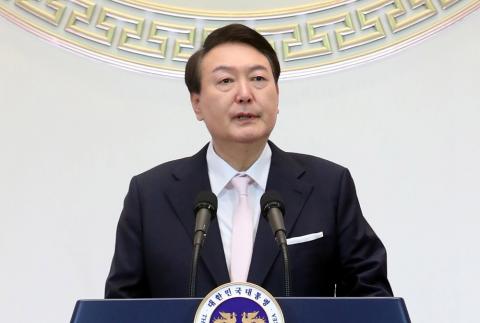
Iran’s Revolutionary Guards have seized a South Korean vessel “for polluting the Persian Gulf with chemicals” amid rising tensions between Iran and the US during the final days of Donald Trump’s presidency.
Iranian news agencies published photos showing Revolutionary Guards speedboats escorting the tanker MT Hankuk Chemi and said the vessel’s crewmembers, including nationals of South Korea, Indonesia, Vietnam and Myanmar, had been detained. The tanker is being held at Iran’s Bandar Abbas port city.
South Korea’s foreign ministry demanded the vessel’s immediate release and said South Korean forces stationed in the strait of Hormuz had been dispatched to the area.
The incident came before an expected visit to Tehran by South Korea’s deputy foreign minister, and against the backdrop of rising tensions between Iran and the Trump administration.
On Monday Iran resumed enriching uranium to up to 20% purity, a significant breach of the 2015 nuclear accord, reducing the time it would take to reach weapons-grade level.
The move, which Iran notified the UN nuclear watchdog about last week, was one of many mentioned in a law passed by Iran’s parliament last month in response to the killing of the country’s top nuclear scientist, which Tehran has blamed on Israel.
Iran started violating the accord in 2019 in retaliation for Washington’s withdrawal from the agreement and the reimposition of US sanctions against Tehran. The enrichment is taking place at the Fordow site, which was built inside a mountain, apparently to protect it from aerial bombardment. The 2015 deal does not allow enrichment there.
“Iran enriching uranium to 20% at Fordow is a clear attempt to increase its campaign of nuclear extortion, an attempt that will continue to fail. The United States and the international community will continue to look to IAEA inspectors to report the facts on the ground,” a US state department spokesperson said.
“We have confidence that the IAEA will monitor and report on any new Iranian nuclear activities.”
The state department also called for the release of the South Korean tanker.
“The regime continues to threaten navigational rights and freedoms in the Persian Gulf, as part of a clear attempt to extort the international community into relieving the pressure of sanctions,” a spokesperson said.
Iran, which has a history of seizing ships if the national flag carrier has a related dispute with Tehran, is furious that South Korea has for months refused to release billions of dollars of Iranian oil-export revenue that it says it needs to purchase anti-coronavirus medicines, including possible vaccines.
In June Iran’s central bank said banks in South Korea were preventing Iran from using the money to buy foods and medicines – trade that is exempt from US sanctions.
Iran announced in June that it had received medicines valued at $500,000 from South Korea after two years of negotiations. At the time, Iran’s foreign ministry said the deal was approved by Washington. It also said South Korea was about $7bn in arrears for oil exported before the Trump administration last year reimposed penalties on Iran’s crude sales. South Korea has always insisted it was working within the sanctions regime imposed by the US, and was working to secure exemptions for humanitarian supplies.
Analysts questioned whether the ship’s seizure was part of an internal Iranian power struggle. Esfandyar Batmanghelidj from Bourse & Bazaar said there had been recent diplomatic progress on the repatriation of the Iranian money from South Korea with the South Korean foreign minister, Kang Kyung-wha, due in Tehran shortly to discuss possible humanitarian payments. It may be that the Iranian hardliners saw the ship’s seizure as a way of disrupting the fledgling diplomacy with the intention they could claim credit and say it was their tougher approach that led to a breakthrough.
South Korea said no chemicals had been spilled by the ship or any rules breached, adding that the ship had been approached by Iranian navy speedboats in international waters.
Sunday marked the first anniversary of a US drone strike that killed the top general Qassem Suleimani, and Washington has apparently been bracing for possible retaliation. Both sides are watching the other warily in the final days of the Trump administration.
After the US stepped up military deployments and threatening language, Iran’s foreign minister, Javad Zarif, accused it on New Year’s Eve of trying to set up a “pretext for war”.
On Sunday the US reversed a decision to bring an aircraft carrier home from the Persian Gulf, with the Pentagon saying that owing to “recent threats” by Iran, the USS Nimitz would stay in position. The original plan to leave the region was intended to be a de-escalatory signal to Iran. The US has already sent extra B-52 bombers across the area.
The European Union had warned that 20% enrichment would mark “a serious deviation” from the commitments made by Iran in the nuclear deal signed in 2015. There will also be fears in Europe that Iran’s brinkmanship could provoke Israel into a military strike.
The Iran nuclear deal’s main aim was to extend the time needed to produce enough fissile material for a nuclear bomb, if it chose to, to at least a year from approximately two to three months. It also lifted international sanctions against Tehran.
The decision to increase the level of enriched uranium is probably directed more at strengthening Tehran’s negotiating hand with the incoming Biden administration.












